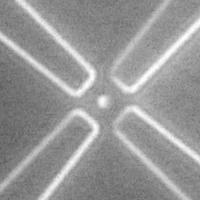The study of the individual molecules of DNA is the most important aspect in personalised medicine research. By isolating and studying the structure of the DNA molecules, researchers would be able to come up with diagnostics, therapies and treatment methods that can be modified as per the patients genetic set up.
 Scientists were able to trap a single particle between four microelectrodes, paving the way for a faster and cheaper way to sequence DNA
Scientists were able to trap a single particle between four microelectrodes, paving the way for a faster and cheaper way to sequence DNA
The width of the individual DNA molecules is 1/50,000th of the diameter of the human hair; hence isolating single molecules for research seems like a mountainoustask in terms of effort and cost. Another challenge in capturing single molecules is the water-based environment, in which they are present. For the past decade researchers have been on the task of isolating the molecules present in an aqueous environment by trying to make them pass through a tiny ‘nanopore’, without much success.
Recently, a research team from the Yale University has come up with a method called “Paul Trapping” that makes use of oscillating electric fields to trap individual molecules. Wolfang Paul, who made the initial discovery, was able to isolate the particles only in vacuum. The team from Yale, however, was successful in isolating a polystyrene bead present in the aqueous solution between four microelectrodes that generated the electric field. The device set up can be confined onto a single chip and it involves low manufacturing costs. Weihua Guan, the lead researcher, explained that using this device doctors would be in a position to perform blood tests on patients and give out the diagnostic results immediately. He added that the chip can also be used to study the response to the stimuli of individual cells. The research team is planning to extend the method to create a three-dimensional trap for DNA molecules.